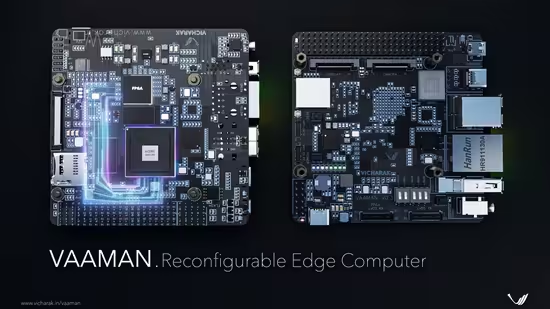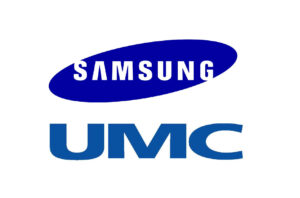Introduction:
In the dynamic landscape of technology, edge computing has emerged as a pivotal paradigm shift, enabling real-time processing and analysis of data at the edge of the network. Indian Startup Vicharak’s breakthrough edge computing board, Vaaman, has quickly risen to prominence, offering unmatched performance, versatility, and innovation.
Processing Power: It is equipped with a powerful six-core ARM CPU and an FPGA (Field-Programmable Gate Array) with 112,128 logic cells, allowing it to handle demanding workloads.
Flexibility: What truly sets Vaaman apart is the ability to customize hardware platforms for specific needs. This is due to the presence of the FPGA, which allows developers to create applications tailored to their requirements.
Real-time Decision Making: Because of its processing power and reduced reliance on cloud computing, Vaaman enables real-time decision making at the edge of the network. This can be crucial for applications that require quick responses.
Platform for Innovation: Vaaman is not just a computing board; it’s a platform that accelerates the development process by enabling rapid testing, prototyping, and simulation of interfaces.
Overall, Vaaman seems to be a powerful and versatile edge computing solution that can be adapted for various applications.
Let’s delve into how Vaaman is reshaping the future of edge computing with its powerful hardware acceleration, parallel computing capabilities, and innovative features.
Read more TSMC to Build 1nm Transistors by 2030 – techovedas

1. Unveiling Vaaman: A Game-Changer in Edge Computing
Vaaman represents the pinnacle of hardware engineering, featuring a robust architecture that includes a six-core ARM CPU and an FPGA with an impressive 112,128 logic cells.
This potent combination provides Vaaman with the horsepower needed to tackle even the most demanding workloads with ease, ensuring optimal performance and efficiency in edge computing applications.
Its design emphasizes scalability, allowing for future upgrades and expansions to meet evolving computational demands.
Here are some examples of workloads that Vaaman’s processing power makes it suitable for, along with a baseline for comparison:
Example workloads suitable for a 6-core ARM CPU:
- Image Recognition: Classifying objects in real-time video streams. This is a common task in many edge applications, such as security systems and industrial automation.
- Sensor Data Processing: Analyzing data from multiple sensors (e.g., temperature, pressure) for anomaly detection or control systems. Predictive maintenance in manufacturing is a great example of this.
- Machine Learning Inference: Running pre-trained machine learning models for tasks like predictive maintenance or object detection on edge devices. This allows for faster response times and reduced reliance on the cloud.
Example workloads that can benefit from FPGA acceleration:
- Video Encoding/Decoding: Processing high-resolution video streams for compression or decompression on the fly. This is essential for applications like video surveillance and autonomous vehicles.
- Cryptographic Operations: Implementing encryption/decryption algorithms for secure data transfer at the edge. This is becoming increasingly important as the need for data security grows.
- Custom Signal Processing: Performing specialized signal processing tasks tailored to specific applications (e.g., filtering noise from sensor data). This can be crucial for applications in fields like medical diagnostics and industrial process control.pen_spark
Read More: What is ARM Neoverse: the IP behind current HPC and datacenter workloads – techovedas
2. Accelerating Innovation with Powerful Hardware and Software Integration
Vaaman stands out for its seamless hardware and software integration. This integration enables Vaaman to excel in various computing tasks.
The synergy between its advanced CPU and FPGA empowers Vaaman. It executes complex algorithms with precision and speed.
This capability makes Vaaman the preferred choice for cutting-edge edge computing applications.
Additionally, Vaaman’s firmware and software stack are optimized for performance and compatibility, ensuring seamless operation across various software environments.
Read More: Samsung Electronics Makes Historic KRW 4 Trillion HBM Deal with AMD – techovedas
3. High-Speed Connectivity: Enabling Real-Time Processing and Low Latency
Vaaman’s standout feature is its 300-MBps link between the FPGA and CPU. This connection facilitates optimized hardware acceleration and parallel computing.
It ensures consistent latency, crucial for real-time processing tasks. Vaaman excels in applications like video and image processing, surveillance systems, and intelligent cameras.
Its high-speed link enables seamless and responsive operation in dynamic environments. Moreover, Vaaman’s efficient data transfer protocols minimize bottlenecks and latency, enabling smooth and responsive operation in dynamic environments.
Read More: AMD & Arm’s Versal Gen 2 AI SoCs: Revolutionizing Embedded AI Efficiency – techovedas
4. Versatility Redefined: A Comprehensive Range of Interfaces
Vaaman offers a comprehensive range of interfaces, including PCI, HDMI, USB, MIPI, audio, Ethernet, Wi-Fi, Bluetooth, BLE, LVDS, and GPIOs.
This extensive array of interfaces makes Vaaman incredibly versatile and adaptable to various application environments, enabling seamless integration and high-speed data transfer across diverse systems and devices.
Its modular design allows for easy customization and expansion, ensuring compatibility with existing infrastructure and future technologies.
Read More: NVIDIA Crowns OpenAI King of AI with World’s First DGX H200 – techovedas
5. Empowering AI and Machine Learning at the Edge
In addition to traditional edge computing applications, Vaaman excels in AI and machine learning tasks, thanks to its powerful processing capabilities.
Vaaman’s advanced CPU and FPGA enable the efficient execution of complex algorithms, contributing to the accuracy and speed of AI and ML systems.
Furthermore, Vaaman’s hardware acceleration capabilities enhance the performance of cryptographic operations, ensuring data security and privacy in sensitive industries.
Its support for popular AI frameworks and libraries simplifies development and deployment of AI applications at the edge, enabling rapid innovation and experimentation.
Read More: TSMC Shatters Moore’s Law: Announces A14 Chip Production Launching the Angstrom Age – techovedas
6. A Platform for Innovation: Customization and Flexibility
Vaaman goes beyond being just a powerful computing board; it is a platform for innovation. Its onboard FPGA empowers developers to create custom hardware platforms tailored to specific needs, accelerating the development process and enabling real-time decision-making at the edge.
This flexibility reduces reliance on cloud computing resources, making edge systems more efficient and responsive to evolving requirements.
Additionally, Vaaman’s comprehensive documentation, development tools, and community support foster collaboration and knowledge-sharing, enabling developers to unleash their creativity and drive breakthrough innovations in edge computing.
Read More: 3 Ethical Implications of AI Enabled VLSI Design – techovedas
Conclusion:
Since Vaaman uses a 6-core ARM CPU, a relevant baseline for comparison could be a single-core ARM Cortex-A55 processor. The Cortex-A55 is a widely used low-power processor found in many mobile devices and embedded systems. Compared to this, Vaaman’s 6-core CPU would offer significantly higher performance for multi-threaded tasks.
It’s important to note that the specific performance of Vaaman will depend on the clock speed of the CPU and the type of FPGA used. However, the combination of a six-core ARM CPU and a powerful FPGA makes Vaaman a compelling option for a wide range of demanding edge computing applications.
As edge computing continues to gain momentum, Vaaman’s impact on this field further solidifies its position as a leading solution in the reconfigurable computing landscape, driving innovation and transforming industries applications, visit Vicharak’s website.




